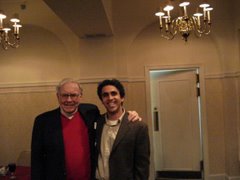Emil Lee from the Motley Fool recently had a chance to sit with Mohnish Pabrai and discuss his investment philosophy, his similarity to Warren Buffet, and his amazing track record. Here are excerpts from the first part of the interview:
Emil Lee: You've modeled your partnership after the Buffett Partnership -- do you mind providing any detail on how that's going? Are you on track in terms of performance, assets under management, etc.?
Mohnish Pabrai: It has gone far better than I would have forecasted. Mr. Buffett deserves all the credit. I am just a shameless cloner. A $100,000 investment in Pabrai Funds at inception (on July 1, 1999) was worth $659,700 on Dec. 31, 2006. That's seven and a half years. The annualized return is 28.6% -- after my outrageous fees and all expenses. Assets under management are over $400 million -- up from $1 million at inception. On all fronts, Pabrai Funds has done vastly better than my best-case expectations.
Going forward, I expect we'll continue to beat the major indices, but with just a small average annualized outperformance.
Lee: You clearly believe in having a broad latticework of knowledge from different educational disciplines from which to draw upon when judging investment ideas. Can you describe how you spend your day? Do you devote a general percentage of your time to reading "non-investment" material versus 10-Ks, etc.?
Pabrai: My calendar is mostly empty. I try to have no more than one meeting a week. Beyond that, the way the day is spent is quite open. If I'm in the midst of drilling down on a stock, I might spend a few days just focused on reading documents related to that one business. Other times, I'm usually in the midst of some book, and part of the day goes to keeping up with correspondence -- mostly email.
I take a nap nearly every afternoon. There is a separate room with a bed in our offices. And I usually stay up late. So some reading, etc., is at night.
Lee: In Trade Like Warren Buffett, you mention that you let investment ideas come to you by reading a lot, and also monitoring familiar names on the NYSE. Can you describe your process of generating investment ideas -- is it simply just reading a lot? Do you do anything else to actively seek out ideas?
Pabrai: The No. 1 skill that a successful investor needs is patience. You need to let the game come to you. My steady-state modus operandi is to assume that I'm just a gentleman of leisure, and that I'm not in the investment business. If something looks so compelling that it screams out at me, saying "Buy me!!," I then do a drill-down. Otherwise, I'm just reading for reading's sake. So, I scan a few sources and usually can find something scream out at me a few times a year. These sources (in no particular order) are:
1. 52-Week Lows on the NYSE (published daily in The Wall Street Journal and weekly in Barron's)
2. Value Line (look at their various "bottoms lists" weekly)
3. Outstanding Investor Digest (www.oid.com)
4. Value Investor Insight (www.valueinvestorinsight.com)
5. Portfolio Reports (from the folks who put out OID)
6. The Wall Street Journal
7. Financial Times
8. Barron's
9. Forbes
10. Fortune
11. BusinessWeek
12. The Sunday New York Times
13. The Value Investors' Club (www.valueinvestorsclub.com)
14. Magic Formula (www.magicformulainvesting.com)
15. Guru Focus (www.gurufocus.com)
Between all of the above, I have historically found at least three to four good ideas every year. Sometimes I make a mistake, and a good idea turns out to be not so good.
Lee: A big part of investing is knowing what to pay attention to and what not to [focus on]. How do you sift through the thousands of investment ideas? Often, bargains are bargains because they're unrecognizable -- how do you spot the needles in the haystack, and how do you avoid the value traps?
Pabrai: I wait to hear the scream. "Buy me!" It needs to be really loud, as I'm a bit hard of hearing.
Lee: Would it be fair to say you are more balance sheet-oriented, versus income/cash flow statement-oriented? If so, how do you get comfortable with the asset values (i.e., Frontline, death care)?
Pabrai: John Burr Williams was the first to define intrinsic value in his The Theory of Investment Value, published in 1938. Per Williams, the intrinsic value of any business is determined by the cash inflows and outflows -- discounted at an appropriate interest rate -- that can be expected to occur during the remaining life of the business. The definition is painfully simple. So, cash can be gotten out of a business in a liquidation or by cash the business generates year after year. It is all a question of what is the likelihood of each. If future cash flows are easy to figure out and are high-probability events, then liquidation value can be set aside. On the other hand, sometimes the only thing that is a high probability of value is liquidation value. Both work. Depends on the situation. But you first need to hear a scream ...
Friday, February 23, 2007
Subscribe to:
Post Comments (Atom)


No comments:
Post a Comment